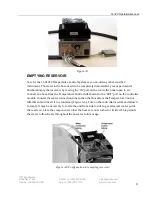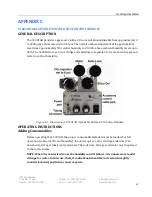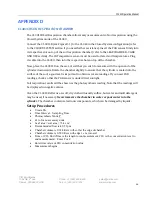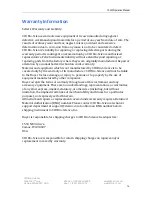
CI-340 Operation Manual
CID Bio-Science
1554 NE 3
rd
Ave
Camas, WA 98607, USA
Phone: +1 (360) 833-8835
Fax: +1 (360) 833-1914
[email protected]
www.cid-inc.com
69
Whole canopy photosynthetic rate (Pn) measurement can be used to quantify integral plant
responses to the environment, as well as for determining the final yield of a crop. While many factors
affect the photosynthetic rate of plants, the CO
2
differential is most accurately established by taking into
account the characteristics of individual plants and the environment they are in for each and every
photosynthesis measurement task. Comparison between plant canopy photosynthesis measurements
and individual leaf measurements can lead to conclusions on sun and shade leaf productivity, as well as
whole plant gas exchange.
Analyzing the CO
2
differential over an entire plant (or plants) can provide researchers with
information concerning entire plant processes, the contribution of shaded leaves to overall
photosynthesis rates, how overall plant productivity or yield relates to canopy photosynthesis or
canopy light interception. The USDA has researched the effects of drought and kaolin-coating on the
leaves of trees, comparing the overall photosynthesis rates of kaolin-coated and uncoated trees. It was
determined that kaolin-coated trees had higher photosynthesis rates, and therefore were more tolerant
of the drought conditions. Other studies into leaf area index and how differing leaf morphologies affect
canopy photosynthesis and plant productivity have also incorporated plant canopy chambers for
photosynthesis measurements.
The CI-340 canopy chamber attachment is designed to be used with various size enclosures,
depending on size of plant or study area. The canopy chamber is a closed system, and air is not
renewed inside of the chamber during analysis. Extremely large chambers have several limitations in
the field such as that leaf temperature, wind patterns and evapotranspiration may not reflect natural
environmental conditions. Also, controlling the temperature of large sun-exposed chambers can be
difficult in the field. However, many of these limitations do not affect small chambers as significantly.
Assembly Instructions
To accurately install the canopy chamber attachment, an air-tight chamber must be formed
around the plant, but light must not be obstructed. The following conditions represent enclosures that
are acceptable:
•
Materials that are not light-reflected, gas-permeable, light-impenetrable (such as plastic bags,
acrylic shells, most glass canopies)
•
Larger than t
he manufacturer’s largest close
system leaf chamber (CI-301LC-10 chamber: 4-
liter volume)
•
Larger than the measuring sample environment
Flexible Chamber Wall
When using a bag or flexible material for the canopy chamber, it is recommended to cut a small
hole (about 65 mm diameter) to help facilitate the chamber attachment. Cut the hole in the side or
bottom of the bag. Line up the “inside” canopy chamber atta
chment piece (the thinner piece with the
thumb screws) with the hole cut in the bag. The bag should be completely inside the seal, but plastic
should NOT cover any of the holes. Plastic should also be kept away from the screws as they are
tightened. Att
ach the “outside” canopy chamber attachment piece (the thicker, larger piece) to the
thinner piece using the thumb screws. Make sure that the bag is tight between the seals and there are
no air leaks. Plastic should be free of the inlet and outlet connectors to the analyzer, as well as the clear
of the hole for the IR temperature sensor to ensure accurate leaf temperature measurements.
Once the
Содержание CI-340
Страница 3: ......








































